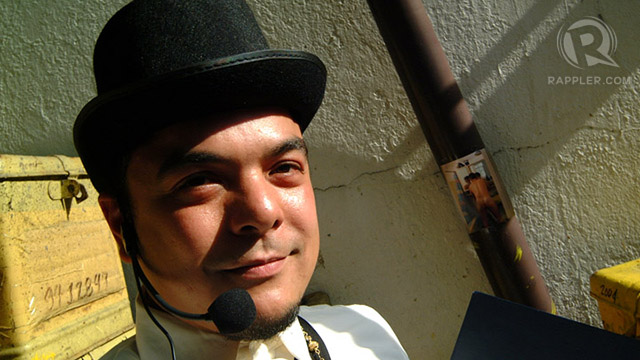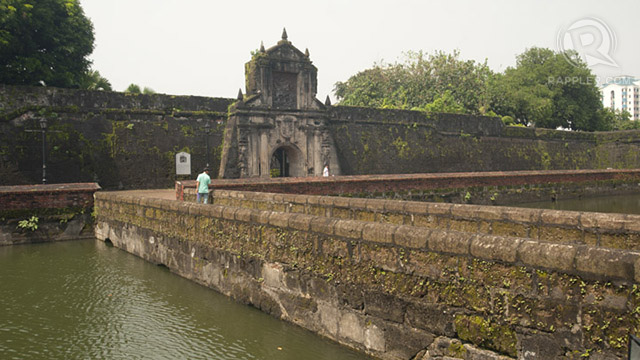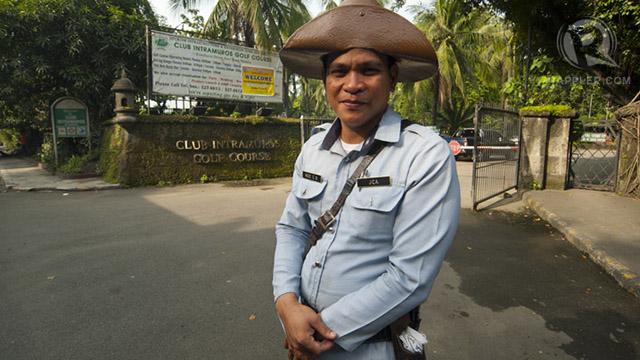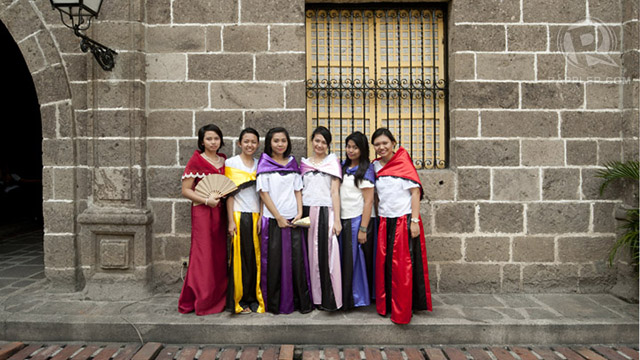SUMMARY
This is AI generated summarization, which may have errors. For context, always refer to the full article.

MANILA, Philippines – By late September 2012, it is still the rainy season and the sky threateningly dark, but some 50 people of all ages and nationalities have turned up for a walking tour of Intramuros, the 16th century Spanish walled city that is the historic core of the sprawling, chaotic Philippine capital.
There is an air of expectancy as they gather around the portly figure of Carlos Celdran, his cherubic face beaming impishly under a black Derby hat. He has promised to “change the way you look at Manila” and adds “the only rule is to bring a sense of humor.”
But Celdran has a serious side beneath the grin. Three years ago, he created a national sensation when he interrupted a service at the Manila Cathedral to tell leading churchmen “to stop getting involved in politics.” Dressed in a top hat and a black coat like National Hero Jose Rizal, he was campaigning against the Catholic Church’s attempts to block family-planning legislation in the Philippine Congress.
Today, in a booming voice, Celdran, 39, asks how many in the group are Filipino and, interestingly, at least half of them raises a hand.
“Usually 50% to 60% of my audience is Filipino,” he tells me later. “It shows how disconnected many Filipinos are from our own history.”

The reasons for detachment are clear: the startling changes the Filipino psyche has undergone through 350 years of Spanish and American colonialism, Japanese wartime occupation, and Chinese economic influence.
In little over a century, the predominant language of instruction in schools, for example, has switched from Spanish to English to Filipino. As a result of such radical changes, Celdran says the Filipino sense of identity is as mixed-up as halo-halo, the local concoction that includes sweetened beans, nata de coco, leche flan, purple yam and jelly, stirred in with shaved ice and ice cream.
He laughingly says his passion for Filipino history is a form of psychotherapy. No wonder. In ethnic terms, Celdran is a typical Filipino cocktail — counting a friar among his forebears, his ancestry Hispanic-Filipino with a splash of Chinese. From an upper middle class family, Celdran got his first job at 14 as a cartoonist for a Manila newspaper; later, he went to the United States, where he studied performance art.
He brings both skills to his historical tours. Over the next 2½ hours, he will give cameo performances — as a Spanish colonial administrator, as Uncle Sam, as General Douglas MacArthur — that are the physical equivalent of cartoons. He strips complex issues down to effective messages and delivers them in a witty and irreverent style, debunking some myths that are still widely held among Filipinos.

Fort Santiago, overlooking the Pasig River that disgorges into nearby Manila Bay, is an apt starting point as this is where colonization began.
When the Spanish conquistador Miguel Lopez de Legaspi, and the Augustinian friar Andres de Urdaneta arrived in Manila Bay in 1571, they found a settlement of 10,000 Muslims who had been trading with Chinese, Japanese, and Malays for centuries.
The Philippine islands were populated by diverse and scattered Indio (native) communities and the Spanish were the first to bring dominion over large parts of the archipelago, with the exception of western Mindanao — which remains largely Muslim — and the upland tribes of Luzon.
Over the next several decades, the Spanish created a beautiful tropical Vatican in Intramuros, building a cathedral and 7 churches out of compressed volcanic ash. This architectural splendor represented the soul of the Philippines, the spiritual equivalent of Indonesia’s Borobodur or Cambodia’s Angkor Wat, argues Celdran.
Myth number 1: Spanish-Catholic colonization was generally a force for good

From the start, King Philip II of Spain — after whom the Philippines was named — had the avowed intention of converting the islands to Christianity. His predecessors in Spain had tried to forcibly convert its Moorish population to Christianity and Philip had ordered the expulsion of Moors from Granada in 1569 after they had resisted suppression of their customs.
In the Philippines, Church and State were inseparable, with the government responsible for religious establishments. Working hand in hand, the Spanish created a feudal system, with the conquistadors owning vast estates worked by Filipinos while the friars fanned out across the islands, building schools and churches and imposing their Catholicism upon a hapless and carefree people.
In fact, says Celdran, over the next 300 years, the Spanish regime was nothing less than a theocracy. He is not critical of religion per se, but of a government that imposes a single faith upon a captive population.
Celdran pretends to look around for concealed spies before he says, “Language is power and, instead of teaching Spanish as they were told to, the friars learned Tagalog and the local dialects. The King’s edict was hijacked by the priests and the Philippines was created and controlled by a friar class — an 18th century Catholic Taliban.”
As he utters the last phrase, a peal of thunder rolls across the sky, the dramatic coincidence raising a laugh among the audience.
Myth number 2: The Ilustrados were mostly Spanish mestizos

The term Ilustrados (“enlightened”), given to the educated class under Spanish rule, gives the impression of a significant Spanish contribution to the national genetic mix. In fact, due to the relatively small numbers of Spanish people, especially women, it was tiny.
Far bigger was the influence of the Chinese, who were trading in the Philippines before the Spanish arrived and soon greatly outnumbered the Spanish. While recognizing their economic importance, the Spanish distrusted the Chinese and kept them out of Intramuros and in the quarter across the river, one cannon shot away in case of trouble.
But most of the early Chinese did assimilate, adopting Christianity and Hispanic names and marrying indigenous Filipinos. In time, Chinese Filipinos (Chinoys) spread beyond Binondo, an important financial district and the world’s oldest Chinatown, to dominate the business sector.
Mestizo culture -— a blend of Chinese, Spanish, and Indio bloodlines — has been a key factor in shaping Filipino identity. (To be continued) – Rappler.com
(Ian Gill is a freelance journalist who has lived in the Philippines for over 25 years. He is a former staffer of the Asian Development Bank’s Department of External Relations, Oil and Gas News, the Asian Wall Street Journal and Asiaweek. He is writing a book and plays golf, struggling with both.)
Add a comment
How does this make you feel?
There are no comments yet. Add your comment to start the conversation.